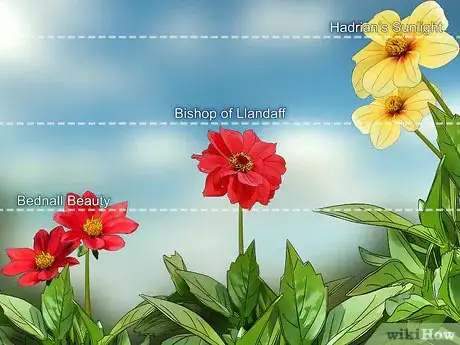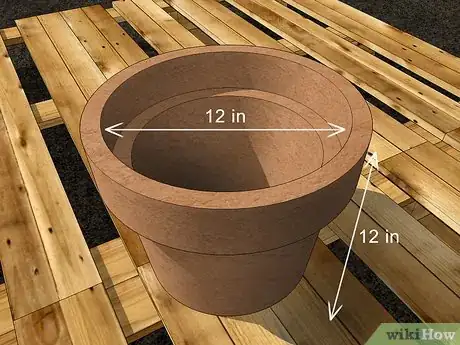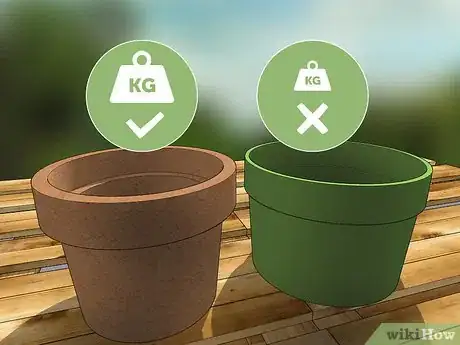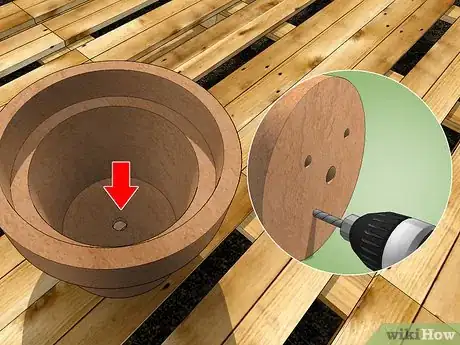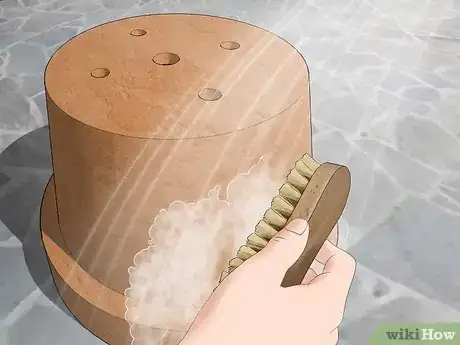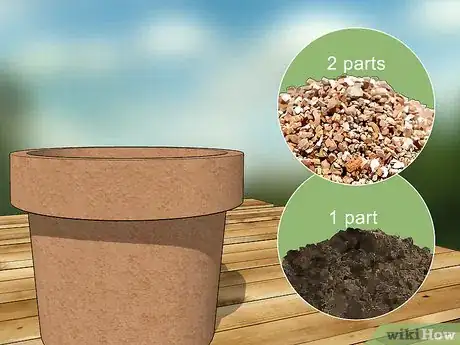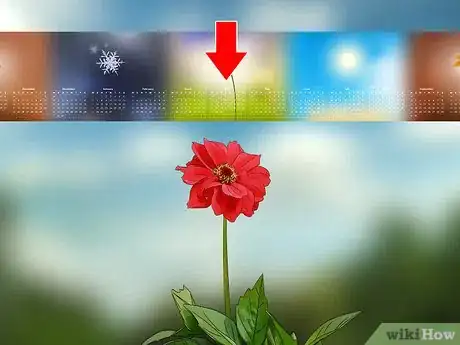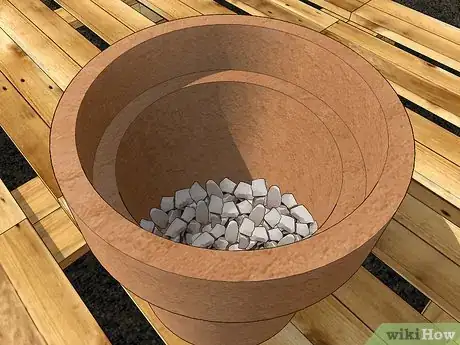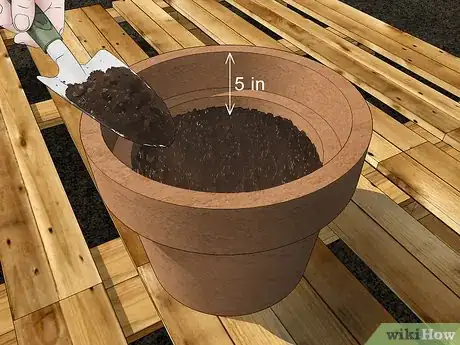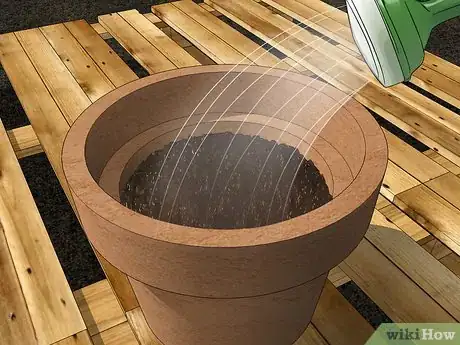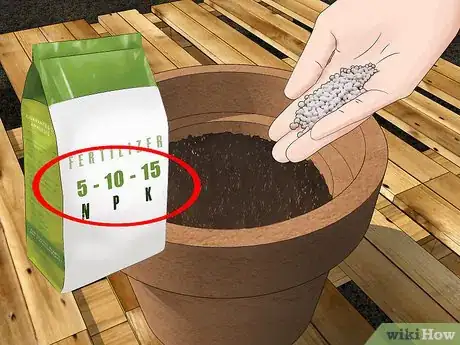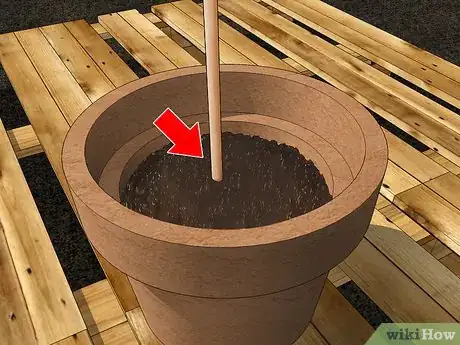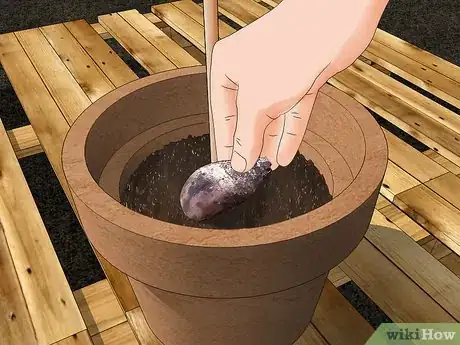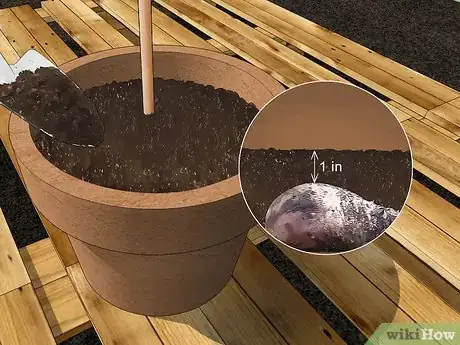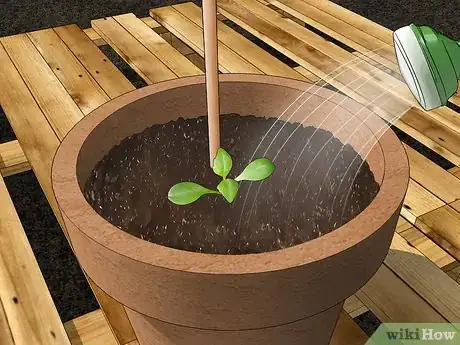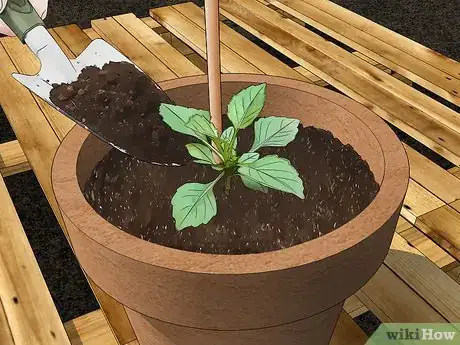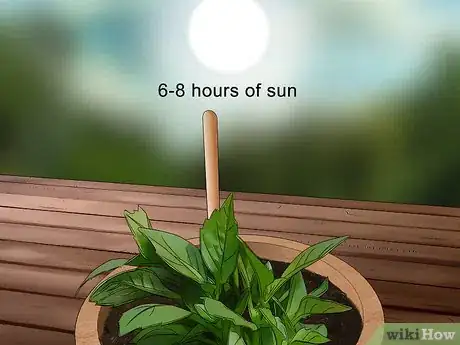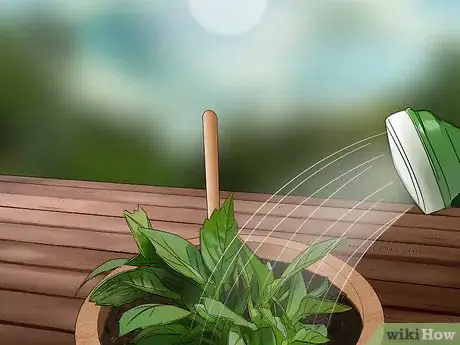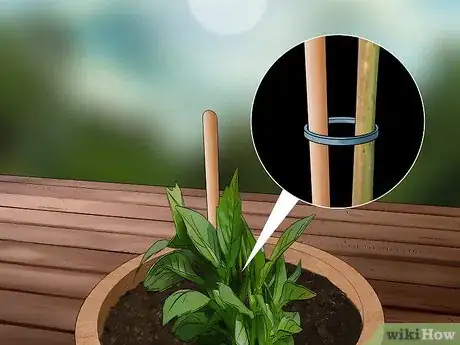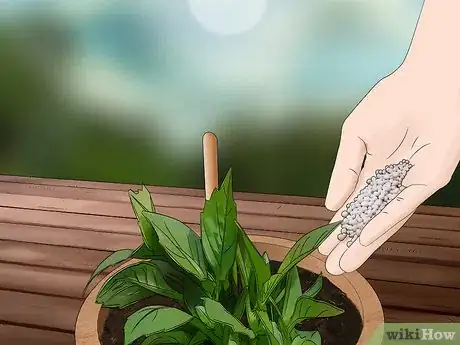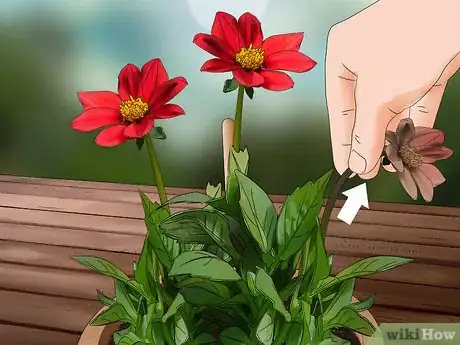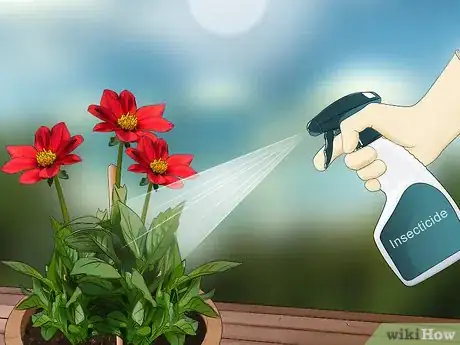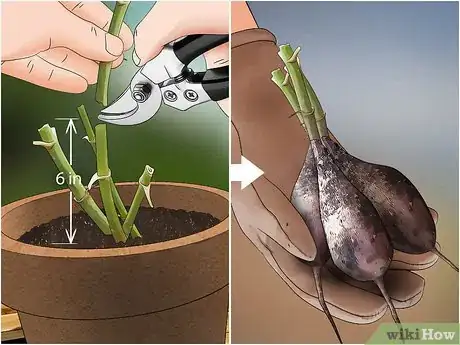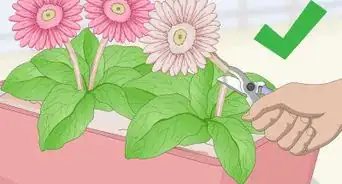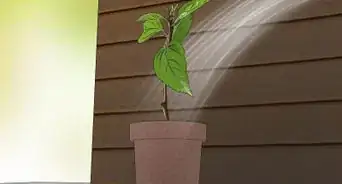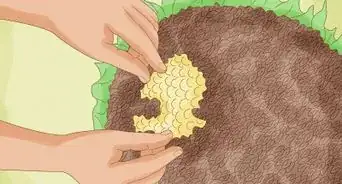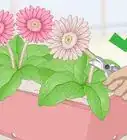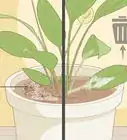This article was co-authored by Lauren Kurtz. Lauren Kurtz is a Naturalist and Horticultural Specialist. Lauren has worked for Aurora, Colorado managing the Water-Wise Garden at Aurora Municipal Center for the Water Conservation Department. She earned a BA in Environmental and Sustainability Studies from Western Michigan University in 2014.
There are 9 references cited in this article, which can be found at the bottom of the page.
wikiHow marks an article as reader-approved once it receives enough positive feedback. This article received 18 testimonials and 100% of readers who voted found it helpful, earning it our reader-approved status.
This article has been viewed 330,411 times.
Dahlias produce bright, beautiful flowers that come in a wide range of colors. Due to their height and weight, many gardeners may feel skeptical about planting them in pots. However, dahlias can thrive in large containers; tall varieties also need a stake for extra support. With the right growing conditions and a little care, you’ll enjoy gorgeous, showy blooms all summer long.
Steps
Providing the Right Growing Conditions
-
1Select a species of dahlia that suits your space. Purchase dahlia tubers online or at a local garden center. Dwarf and low-growing varieties are best for container growing. Some varieties can grow as tall as 5 feet (1.5 m), so you’ll need a much larger pot if you choose a tall species.[1]
- Small to medium varieties include Bednall Beauty, which grow up to 2 feet (61 cm), and Bishop of Llandaff, which grow up to 3 feet (0.91 m). Larger varieties include Hadrian’s Sunlight and Twyning’s After Eight, which grow 4 feet (1.2 m) or higher.[2]
- A single tuber needs about 1 to 2 feet (30 to 61 cm) of space, so you’ll probably only need 1 per container.[3]
-
2Pick out a pot that’s at least 12 by 12 inches (30 by 30 cm). Go for a heavy pot that’s at least 12 inches (30 cm) deep with a diameter of at least 12 inches (30 cm). Pots this size usually hold around 5 to 7 gallons (19 to 26 L) of soil.[4]
- For the largest varieties, go with a 24 by 24 inch (61 by 61 cm) pot, which usually holds around 25 gallons (95 L) of soil.
Advertisement -
3Choose a heavy pot if you’ve chosen a tall variety. Varieties that grow 3 to 5 feet (0.91 to 1.52 m) can become top-heavy, and a lightweight pot may not be sturdy enough to support their weight. Additionally, tall varieties require a stake, which will add even more weight.[5]
- Plastic containers are lightweight, so go for sturdy ceramic or terracotta pots instead.
- Keep in mind terracotta and unglazed ceramic pots absorb water, so they can freeze and crack if they’re left out during the winter.[6]
-
4Drill drainage holes, if necessary. This step may not be necessary if the container already has several drainage holes that allow excess water to drain. However, if your pot has small holes or only has 1 center hole, drill a few extra holes to improve drainage.[7]
- Dahlias grow best in well-drained environments. While they require lots of water, their fine roots are prone to rotting if the soil is too waterlogged.
- Fill the bottom with 2 inches (5.1 cm) of gravel for improved drainage.
-
5Clean the pot with mild soap and warm water. A dirty pot could spread disease, and hidden insect eggs may be lying in wait at the bottom of the pot. Remove these threats by cleaning the container before you plant. Gentle soap and water will do the trick.[8]
- Be sure to thoroughly rinse away all soap residue.
- It’s particularly important to wash the pot if you’ve used it for other plants in the past.
-
6Choose a rich, well-draining potting mix. Standard potting soil alone is too porous and may lead to pour bud formation. For a good potting mix, combine 2 parts potting soil with 1 part peat moss or well-aged manure.[9]
- Note that garden soil isn’t suitable for container plants. Be sure you purchase potting soil labeled for potted plants.
Planting Your Dahlias
-
1Plant your dahlia tubers in the middle of spring. Dahlias should be planted in spring, or from April through early June in the Northern Hemisphere. They’re are frost-sensitive, so keep the container outdoors only when there’s no threat of freezing temperatures.[10]
- If your area is prone to frost in the spring and you don’t want to wait to plant, start your dahlias indoors, then move them outside.
-
2Line the bottom of the pot with a thin layer of gravel. Placing gravel at the bottom of your pot also accomplishes this task, as long as you keep the layer less than 1⁄2 inch (1.3 cm) deep.[11]
-
3Add soil to within 5 to 7 inches (13 to 18 cm) of the container’s rim. Don’t pack the soil tightly. Pour it into the container, and let it remain loose. Remember that dahlias like loose, well-draining soil.[12]
- Eventually, you’ll plant your dahlia tuber about 4 to 6 inches (10 to 15 cm) deep, and you’ll want to leave 1 inch (2.5 cm) between the surface of the soil and the rim of the pot at the end of the planting process.
- To meet these measurements, start by adding soil to within 5 to 7 inches (13 to 18 cm) of the rim.
-
4Water the soil lightly, but don’t soak it. The soil should be damp, but not so wet that it gets packed. Try using a watering can to dampen the soil instead of blasting it with a garden hose.[13]
-
5Mix fertilizer into the top layer of soil. Dahlias need a lot of nutrients, and mixing fertilizer into the soil where the roots will develop will give your plant a head start. Use a slow-release, general purpose fertilizer, or go with an organic option, such as bone meal or seaweed fertilizer.[14]
- Any fertilizers recommended for flowering plants or vegetables are suitable for dahlias.
- You might find store-bought fertilizers with N-P-K numbers, which stand for nitrogen, phosphorus, and potassium. Good choices for dahlias include 5-10-15, 5-10-10, and 10-20-20 fertilizers.
- Use a fertilizer with a higher nitrogen value earlier in the season and reduce it over time.
- Read your product’s instructions, and use it as directed.
-
6Bury a stake in the pot to support large dahlia varieties. If you’ve selected a variety that will grow more than 3 feet (0.91 m) tall, you’ll need to support it with a sturdy metal or wood stake. Place the stake in the soil before planting the tuber. If you bury the stake after planting, you’ll risk injuring the tuber and its root system.[15]
- Insert the stake in the soil next to where you’ll place the tuber. Choose a stake that will touch the bottom of the pot and extend at least 3 feet (0.91 m) above the soil’s surface.
- For a 12 inch (30 cm) pot, go with a 4 foot (1.2 m) stake.
- Tie the stem to the stake loosely as it grows.
-
7Plant the tuber in the soil on its side. Lay the tuber down horizontally with the eye centered in the middle of the pot. The eye is where the stalk will sprout, so place the tuber on a slight angle so the eye faces upward.[16]
- The eye looks like a bud, and it’s located on the opposite side of the tuber’s roots.
-
8Cover the tuber with about 1 inch (2.5 cm) of pre-moistened soil. Don’t bury the tuber with lots of soil just yet. Instead, cover it with a 1 inch (2.5 cm) of layer of damp soil to allow the stalk to grow.
-
9Water new sprouts lightly, but be sure not to drown them. Stick your finger into the soil to test it. If it feels moist, don’t add any more water. If it's dry, sprinkle just enough warm water to moisten the surface.[17]
- You don’t want the soil to dry out completely, but the young tuber will rot if you soak it.
- Unless you live in a hot climate, you might not need to water at all until the first shoots and leaves emerge from the soil.[18]
-
10Add small amounts of soil as the stalk grows. Do so carefully to avoid damaging the young stalk, since it’s still fragile at this stage. Cover the new stalk with a little soil up to the top set of leaves; be sure these leaves remain above the soil.
- As the stalk grows, continue adding small amounts of soil until 1 inch (2.5 cm) of empty space remains between the top of the soil and the rim of the pot.
- Dahlias grow quickly, and you’ll see substantial foliage within 2 weeks. Blooms typically appear about 8 weeks after planting.
Caring for Your Plants
-
1Keep the pot in full sun. Dahlias grow best with 6 to 8 hours of direct sunlight. For best results, choose a spot that gets full sun from the morning through midday. Try to find a spot that will also provide partial shade from intense afternoon light, especially if you live in a hot climate.
- If you keep your dahlia indoors, you’ll need to supplement sunlight with fluorescent plant lights.
- You’ll also need supplemental lighting if you’re starting your plant indoors in early spring. Set the light about 6 inches (15 cm) above the top rim of the pot for newly planted tubers and raise the light as the plants grow.
-
2Water the tubers deeply once the stalk extends above the rim of the pot. Give them a thorough watering 2 or 3 times a week. Dahlias growing in hot, dry climates may need daily watering. While you should water thoroughly and keep the soil moist, the soil shouldn’t be soggy or waterlogged.
-
3Tie the stalk to the stake when it reaches a height of 1 foot (30 cm). Use twine or nylon string to secure the stalk to the stake. As the stalk grows, tie it to the stake in 1 foot (30 cm) intervals.[19]
-
4Fertilize the flowers once every 2 weeks throughout blooming season. Go for a liquid fertilizer with higher concentrations of phosphorus and potassium. Good N-P-K combinations include 8-24-16 and 0-20-20.
- Higher amounts of phosphorus promote blood production, and potassium encourages root development.
- Apply your product according to its label’s instructions.
-
5Prune and deadhead regularly to encourage healthy growth. Flowers last 4 to 6 days, then fade and die. Clip spent flowers as you see them to encourage further bloom production. Remove the bottom leaves by the middle of summer, or around mid-July in the Northern Hemisphere.[20]
- Pinch back the tips before flower buds form when the plant is about 16 inches (0.41 m) tall to encourage a bushier growth.
- Removing the bottom leaves improves air circulation, which reduces the risk of mildew.
-
6Spray your dahlia with fungicide or insecticide as needed. Dahlias are prone to a number of pests, including mold, earwigs, slugs, spider mites, aphids, and cucumber beetles. To prevent infestation and infection, apply a combination insecticide and miticide every 7 to 10 days once the plant grows to a height of 6 inches (15 cm).
- Find a chemical insecticide and miticide labelled for flowering plants at your local garden center. Apply your product as directed.
- Use organic insecticides, such as horticultural soap or neem oil, for a more natural approach.
-
7Store the tuber in a cool, dry place during winter. The first freeze will kill the plant’s leaves and stalk. When this happens, cut the stalk to a height of 6 inches (15 cm). Allow 2 weeks for the tuber to harden in the pot, then carefully dig it out of the pot. Rinse it, let it air dry for a day, then pack it in paper, sawdust, or perlite.[21]
- Store the tuber in a dry, dark place that’s 40 to 50 °F (4 to 10 °C) during the winter, then replant it in the spring.
Community Q&A
-
QuestionI put dahlias in a large pot this year and set them on my deck where they get plenty of sun, and they looked beautiful. Then the leaves started curling up and dying, the buds started rotting before they bloomed, and the few that did bloom were very small and sick looking. What can I do?
 Community AnswerStrip it down to about 5 growing stems. Remove the lower leaves in July to help air circulation and feed with tomato food once a week (at half strength). Don't allow too many buds. If you want loads of flowers you will need a rich, well drained compost and regular feeding.
Community AnswerStrip it down to about 5 growing stems. Remove the lower leaves in July to help air circulation and feed with tomato food once a week (at half strength). Don't allow too many buds. If you want loads of flowers you will need a rich, well drained compost and regular feeding. -
QuestionHow do I make my dahlias bloom? The plant itself looks healthy but I don't see any buds forming. And how is dead heading done to promote thick foliage?
 Jared ButlerCommunity AnswerDahlias usually bloom about 8 weeks after planting. If it's been longer than that, your plant might not be getting enough sun. Make sure it gets about 8 hours of direct sunlight daily. If you didn't fertilize it, apply a low-nitrogen, high-phosphorus fertilizer. As for dead-heading, removing spent flowers encourages the plant to sprout new buds.
Jared ButlerCommunity AnswerDahlias usually bloom about 8 weeks after planting. If it's been longer than that, your plant might not be getting enough sun. Make sure it gets about 8 hours of direct sunlight daily. If you didn't fertilize it, apply a low-nitrogen, high-phosphorus fertilizer. As for dead-heading, removing spent flowers encourages the plant to sprout new buds. -
QuestionCan I keep a dahlia in a pot in the house over the winter?
 Community AnswerYou can bring it in, but I don't expect it to flourish and bloom indoors because of the dry air and short days. After a frost kills the top, let it sit for a day or two to allow the moisture to drain into the tubers. Then cut off the dead stuff, but leave a bit of stem attached. You can bring the entire pot indoors, into a cool, dark area. Only water occasionally during the winter to keep it from becoming bone dry. Better yet, you could unpot it and shake off the soil and let it dry. Then put it in a paper bag in a cool, dark place. The idea is to keep it dormant until it can go outdoors next spring. Check it about once a month in winter, and if it seems too dry, soak it in a pail of water for a few minutes and then let it dry again.
Community AnswerYou can bring it in, but I don't expect it to flourish and bloom indoors because of the dry air and short days. After a frost kills the top, let it sit for a day or two to allow the moisture to drain into the tubers. Then cut off the dead stuff, but leave a bit of stem attached. You can bring the entire pot indoors, into a cool, dark area. Only water occasionally during the winter to keep it from becoming bone dry. Better yet, you could unpot it and shake off the soil and let it dry. Then put it in a paper bag in a cool, dark place. The idea is to keep it dormant until it can go outdoors next spring. Check it about once a month in winter, and if it seems too dry, soak it in a pail of water for a few minutes and then let it dry again.
Things You'll Need
- Dahlia tubers
- Large, heavy pot
- Garden trowel
- Potting mix
- Fertilizer
- Metal or wood stake
- Twine
- Pruning clippers
References
- ↑ https://dahlia.org/growing/fundamentals-of-growing-dahlias/
- ↑ https://www.rhs.org.uk/advice/profile?PID=592
- ↑ https://www.bhg.com/gardening/flowers/bulbs/dahlia-flowers/
- ↑ http://planttalk.colostate.edu/topics/annuals-perennials/1094-planting-dahlia-tubers/
- ↑ http://www.victoriadahliasociety.org/2011/04/you-dont-need-a-garden-to-grow-dahlias/
- ↑ https://content.ces.ncsu.edu/extension-gardener-handbook/18-plants-grown-in-containers#weight
- ↑ http://www.dahlia-nds.co.uk/about_dahlias/Dahlia_Cultivation.htm#prepare
- ↑ http://extension.uga.edu/publications/detail.html?number=B1318&title=Growing%20Indoor%20Plants%20with%20Success
- ↑ http://www.victoriadahliasociety.org/2011/04/you-dont-need-a-garden-to-grow-dahlias/
- ↑ https://dahlia.org/growing/fundamentals-of-growing-dahlias/
- ↑ http://www.victoriadahliasociety.org/2011/04/you-dont-need-a-garden-to-grow-dahlias/
- ↑ http://planttalk.colostate.edu/topics/annuals-perennials/1094-planting-dahlia-tubers/
- ↑ http://planttalk.colostate.edu/topics/annuals-perennials/1094-planting-dahlia-tubers/
- ↑ http://www.victoriadahliasociety.org/2011/04/you-dont-need-a-garden-to-grow-dahlias/
- ↑ https://www.bhg.com/gardening/flowers/bulbs/dahlia-flowers/
- ↑ http://planttalk.colostate.edu/topics/annuals-perennials/1094-planting-dahlia-tubers/
- ↑ http://planttalk.colostate.edu/topics/annuals-perennials/1094-planting-dahlia-tubers/
- ↑ https://www.bhg.com/gardening/flowers/bulbs/dahlia-flowers/
- ↑ https://www.bhg.com/gardening/flowers/bulbs/dahlia-flowers/
- ↑ https://www.rhs.org.uk/advice/profile?PID=592
- ↑ http://extension.colostate.edu/topic-areas/yard-garden/spring-planted-bulbs-corms-and-roots-7-411/
About This Article
If you want to grow dahlias in pots, choose a pot that's at least 12 inches by 12 inches and fill it with a rich potting mix, like 2 parts compost to 1 part peat moss. Then, plant your dahlia tubers on their sides about 4-6 inches deep in the soil during spring. Once the tubers are planted, water the soil lightly so it's damp but not soaked, and mix a fertilizer into the top layer of soil. To help your plants grow, place the pot in an area that gets direct sunlight and water at least 2-3 times a week. For tips on how often to fertilize the flowers and how to prune them, keep reading!
